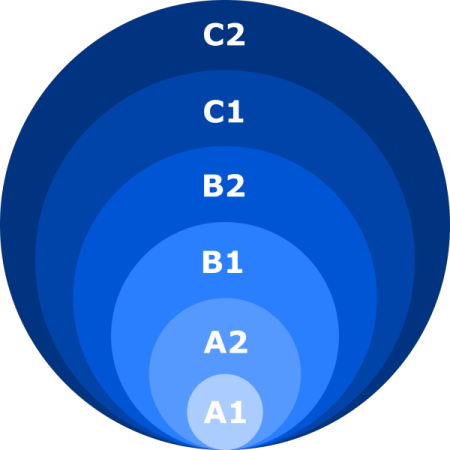The Common European Framework of Reference (CEFR) for Language
This system was created by the Council of Europe in order to harmonize the levels of language exams in different regions. The CEFR is widely used around the world, with all important tests linked to it.
scope of language education
for teaching & learning
mediation & online interaction
social inclusion & democracy
About CEFR
The CEFR is a technique for determining and describing language levels in foreign language students. If you are studying English, you should be familiar with the CEFR because it is frequently used in language schools, educational materials such as textbooks, and exams.
It was first published in 2001 and was created for usage in Europe in order to enhance educational transparency (making education clear and easy to grasp) and to allow for job or study travel between EU countries. It has since been translated into 37 languages and is currently used worldwide, not just in Europe.
CEFR is divided into six levels: A1 (lowest), A2, B1, B2, C1, and C2 (highest). The letters "A" stand for "basic user," "B" for "intermediate user," and "C" for "proficient user."

The levels are determined by a set of "can do" statements that explain what you can do in the language you're learning (in this case, English). A learner, for example, can 'identify themselves' at level A1 and "can speak about a wide range of themes" at level B2. Speaking interaction (having a conversation), spoken production (what you can say), listening, reading, and writing are all covered by the can-do assertions.
Objectives of CEFR
The CEFR provides a common basis for the elaboration of language syllabuses, curriculum guidelines, examinations, textbooks, etc. across Europe.
It describes in a comprehensive way what language learners have to learn to do in order to use a language for communication and what knowledge and skills they have to develop so as to be able to act effectively. The description also covers the cultural context in which the language is set.
- 1Promoting plurilingualism and diversification in the choice of languages in the curriculum.
- 2Supporting the development and demonstration of the plurilingual profile of individual learners.
- 3Developing and reviewing the content of language curricula and defining positive "can do" descriptors adapted to the age, interests, and needs of learners.
- 4Designing and developing textbooks and teaching material.
- 5Supporting teacher education and cooperation among teachers of different languages.
- 6Enhancing quality and success in learning, teaching and assessment.
- 7Facilitating transparency in testing and the comparability of certifications.
Why You Need CEFR?
The CEFR divides language proficiency into six levels, from A1 to C2, which can be further subdivided according to the needs of the local context. The CEFR divides language proficiency into six levels, A1 to C2, which can be regrouped into three broad levels: basic user, independent user, and proficient user. "Can-do" descriptors are used to define the levels. The levels did not come out of nowhere in 2001, but rather evolved over time, as stated further below.
There are language certificates in various languages that are valid in all European countries and can be written by anyone. The locations where you can take the exam are spread across Europe. As a result, everyone has the opportunity to take an exam.
The fundamental skills required for effective communication are critical. As a result, every language exam has four parts: "writing," "reading," "listening," and, of course, "speaking."
In Europe, there are, of course, various educational systems. Every country has one. These obstacles, however, could be overcome with the help of the CEFR.
Not only is communication crucial in everyday life, but it is also important in the workplace. As a result, every learner has the opportunity to study specific language in a professional setting, for example.
Because the educational topics and qualifications are transparent, both language learners and teachers can learn and work more independently (for example, with educational books that are created with the aid of the CEFR).
Global scale
For various purposes, it is preferable that the shared reference points be presented in various ways. However, for some purposes, a holistic summary table of the proposed common reference levels will be suitable. It will be easier to describe the system to non-specialist users with such a simple "global" depiction, and it will give orientation points for teachers and curriculum planners.
A1
A2
B1
B2
- Can understand the main ideas of complex text on both concrete and abstract topics, including technical discussions in his/her field of specialization.
- Can interact with a degree of fluency and spontaneity that makes regular interaction with native speakers quite possible without strain for either party.
- Can produce clear, detailed text on a wide range of subjects and explain a viewpoint on a topical issue giving the advantages and disadvantages of various options.
C1
C2
- Can understand with ease virtually everything heard or read.
- Can summarize information from different spoken and written sources, reconstructing arguments and accounts in a coherent presentation.
- Can express him/herself spontaneously, very fluently and precisely, differentiating finer shades of meaning even in more complex situations.
BASIC USER | INDEPENDENT USER | PROFICIENT USER | |||
A1 | A2 | B1 | B2 | C1 | C2 |
|
|
|
|
|
|
Get started today!
Diagnostic Test --- Cambridge English Placement Test
(CEPT)
(Developed by Cambridge Assessment English)

A comprehensive international evaluation of English ability that covers all key language-learning skills. The outcomes are mapped to the Common European Framework of Reference for Languages (CEFR), which is the international standard for describing language ability.
About CEPT
The Cambridge English Placement Test is an online test that is quick and accurate for centers and institutions.
It can be used for: placing students on English language courses; determining what level of English ability students have; which course is best for them; and which Cambridge English exam they should take; determining whether students need to attend a pre-sessional course or an in-sessional language improvement course.
The CEPT test results will be used to assess the students' current English language skills and to help them understand where they stand on the CEFR scale.
Why use the Cambridge English Placement Test?
- Fast
- Reliable
- Flexible
- Easy to manage
- International
- Suitable for all students: Adaptive test
- Instant results you can trust
Analyze yourself now!
Progress will be measured at each stage of learning over the course of a lifetime!
Frequently asked questions
The CEFR was created to serve as a foundation for all European languages. It can be used for any language in the world because it is language-neutral. It was created in 38 different languages, including Arabic, Chinese, and Japanese.
It's difficult to give a clear answer to this question, partly because the situation is constantly changing, and partly because it's difficult to say how many organizations in a country must recognize the CEFR before we can say it's widely accepted. We are aware of organizations in nearly every country where we work that make some reference to the CEFR. It is certainly recognized in all European countries, but many countries in Asia, the Middle East, Latin America, and Australasia are increasingly referring to it at national or regional policy levels. The CEFR is increasingly being used by universities, schools, and colleges to describe language levels.
Arabic, Albanian, Armenian, Basque, Bulgarian, Catalan, Chinese, Croatian, Czech, Danish, Dutch, English, Esperanto, Estonian, Finnish, French, Friulian, Galician, Georgian, German, Greek, Hungarian, Italian, Japanese, Korean, Lithuanian, Moldovan, Norwegian, Polish, Portuguese, Russian, Serbian (Iekavian version), Slovak, Slovenian, Spanish, Swedish, Turkish and Ukrainian, according to the Council of Europe
The Council of Europe's website http://www.coe.int/t/dg4/linguistic/Cadre1 en.asp contains a wealth of information. The Common European Framework of Reference for Languages, published by Cambridge University Press, is the key document (ISBN Hardback 0521803136 Paperback: 0521005310). This is a comprehensive and detailed book that covers all aspects of the CEFR.